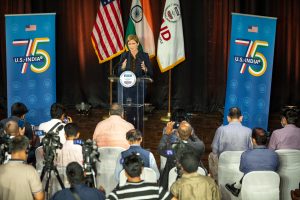As Indian Prime Minister Narendra Modi is in the United States this week, all eyes are on the India-U.S. relationship, particularly in the realms of defense and technology. But India-U.S. ties reached a milestone in another direction in May 2023, when the U.S. Agency for International Development (USAID) and the Indo-American Chamber of Commerce (IACC) renewed their Memorandum of Understanding (MoU) for the next five years. The MoU brings in the Indian and the American private sector to chase objectives in sectors like climate change, health, economic growth, education, and women’s empowerment.
Beyond the bilateral dimension, such cooperation opens up the possibility for joint projects in third countries. Indeed, there are several common interests – from mitigating and responding to climate change to job creation – that New Delhi and Washington can pursue in third countries. Amid the ever deeper and wider upswing in India-U.S. ties, this momentum can be leveraged to not only further strengthen their bilateral ties and cooperation, but also extend to island nations in the Indian Ocean Region and beyond. By cooperating in their development projects in third countries in the Indian Ocean, India and the U.S. can realize the evolving significance of the Indo-Pacific region in the policy focus of both countries.
Maldives, an island nation in the heart of the Indian Ocean region, is a crucial part of the puzzle. With Maldives’ northernmost island just 130 km from Minicoy, the southernmost island of Lakshadweep (an Indian island territory in the Arabian Sea), the near neighbor is of immense importance to India. Meanwhile, Maldives’ southernmost atoll is roughly 1,200 km from the U.S. military base at Diego Garcia. In terms of location alone, Male boasts immense geostrategic and geoeconomic significance in the Indian Ocean and India’s immediate neighborhood.
Recent trends in bilateral relations have borne this out. New Delhi-Male relations in particular are strengthening from pillar to post. To quote Maldives Foreign Minister Abdulla Shahid at an event in Washington, India is a “sibling” with whom Maldives shares outstanding relations based on respect. Their development partnership was given further momentum with the recent signing of 10 key agreements focusing on higher education, sports, arts, and health. These developments are happening at a time when Maldives’ importance in India’s Neighborhood First is finding resonance with Male’s “India First” approach as the former faces elections in September 2023.
At the same time, Maldives’ importance for the U.S. is gaining significance amid its Indo-Pacific strategy, particularly as Washington looks to strengthen the “Indo” pillar. In June 2023, Samantha Power, the USAID administrator, discussed burgeoning shared priorities like climate change, opportunities for young people, democracy and human rights with Maldives’ Foreign Minister Abdulla Shahid. This was in addition to USAID promising additional support of $7.2 million from the United States over the next year. Maldives-U.S. relations also received a boost with the reopening of the Maldives Embassy in Washington for the third time.
Amid these bilateral advances, how can India and the United States work together in Maldives?
Triangular cooperation bringing together India and the U.S. with the countries in Asia and Africa predates the conceptualization of the Indo-Pacific, with the initial interests being reinforced in the 2016 Joint Statement when Modi visited Washington. Development cooperation has manifested itself in the form of capacity-building measures. In the past, both India and the U.S. have taken some successful triangular development initiatives like the Feed the Future program and Agriculture Innovation Partnership in Africa, the South Asia Regional Initiative for Energy Integration, and many others.
Today, climate change is one of the prime existential issues concerning many island nations. Maldives is especially at risk; at just 2.4 above sea level, it is the world’s lowest-lying country. Even a slight increase in sea level, just half a meter, can inundate large parts of the country. The fear of such consequences can already be seen in the growing climate migration of the people to nearby littoral countries like India and Australia.
Being an island nation, whose economy depends on tourism and fishing, any impact on the maritime infrastructure will seriously destabilize the country. This opens the opportunity for India and the United States to come together in undertaking resilient infrastructure projects in Maldives. With India spearheading organizations like International Solar Alliance (ISA) and Coalition for Disaster Resilient Infrastructure (CDRI), it’s an opportune moment for India and the U.S. to respond to the needs of island nations. With both countries having considerable interest in Maldives, it’s the right time to play the tune.
With the evolving dynamics of great powers in the Indo-Pacific region, island nations are fearful of being caught in a battle of “the U.S. versus China.” A more positive branding of “U.S. and India” will win a warmer welcome. Through joint initiatives in third countries that address key local concerns, New Delhi and Washington will be able to garner support from the citizens of the respective countries and also create a positive narrative toward the India-U.S. partnership in the Indo-Pacific region.
Having an enduring presence in Male will further allow India and the U.S. to enjoy considerable weight and influence in the Indian Ocean Region, which will also showcase the combined ability of the partners to lead in the third countries. The trio of New Delhi-Washington-Male alone will not significantly advance the India-U.S. partnership in the Southern Indian Ocean, but such triangular collaborations can also be replicated in other island countries, whether in the Indian Ocean or the Pacific.

































